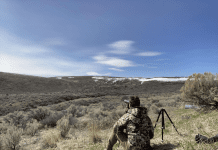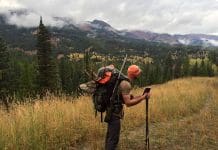Pack a Raft to Expand Your Options
Luke Moffat
Alaska’s road system is very limited. Therefore, accessing much of the state is relegated to those with alternate modes of transportation like boats, planes, snow-machines, horses, and ATVs. The pack-raft is a versatile and lightweight transportation option I have been using to expand my range so I can more effectively access some prime hunting country in Alaska’s vast back-country.

Pack-rafts are basically just what they sound like… a lightweight raft that you pack on your back. Only a few companies make boats in this category and they typically range in weight from 3-17 pounds depending on the size and payload. One of the better known manufacturers of these boats is Alpacka Raft. They offer several different boat models including my personal choice, the Denali Llama. It comes in at just under 7 pounds with a spray deck and inflation bag included.

The spray deck is a thin covering over the boat deck designed to keep a large portion of the water off of you and out of your boat. I would strongly suggest getting a packraft with a spray deck; without it you might find yourself sitting in a floating bathtub after a run through a set of rapids.

The inflation bag is a lightweight and ingenious way to inflate the pack-rafts. The inflation bag is a nylon sack with a threaded fitting that mates to the air inlet of the boat. To use one, first thread the fitting onto the boat, and open the bag to fill it with air and close off the open end. Then, just squeeze the trapped air into the boat. Repeat the process until the boat is full of air. At less than 5 oz. you hardly know the inflation bag is there until you need to fill your boat. Then you’ll be thankful you brought it because it will save you a headache and a bunch of time compared to blowing it up manually.
In addition to the 7 pound raft, you’ll need a set of paddles and you should definitely plan to pack and use a personal flotation device (PFD). Paddles usually tip the scale at 2 – 2.5 pounds and a PFD typically weighs around 1.5 pounds. That pound and a half for the PFD might seem like a burden but it can be the difference between life and death in the event something goes wrong on your float.
As you can see, packrafting will add a hefty 10 – 12 pounds to the weight of your normal hunting pack. Is it really worth it? Well, every situation is different, but a pack-raft typically will allow you to travel further into the backcountry knowing that on your return you’ll be floating back down the stream/creek/river effortlessly with nothing on your back.
I find the extra 10 – 12 pounds in my pack going in is more than worth it if I don’t have to carry a 100+ pound pack out of the backcountry after I take an animal. Being able to float a good portion of the way back out instead of backpacking the load gives me the confidence to go a few extra miles.
Pack-rafts loaded up after a successful Dall sheep hunt 20+ miles from the truck
I don’t solely use my pack-rafts for hunting. In fact, I use them for fishing and more often during the summer scouting seasons. They’re amazing tools for thru-hikes and lengthy exploratory trips. I’m constantly amazed at the distances you can cover by hiking and pack-rafting. It really opens up a lot of potential hunting area that you couldn’t feasibly access due to the sheer distances and/or time & effort needed to retrieve downed game from the field.

One of the newer models of pack-rafts to come out is called the “Big Rig” made by FeatherCraft. This boat is tailored to specifications provided by Larry Bartlett, the owner of Pristine Ventures. The weight of this packraft is significantly more, coming in at 17 pounds. However, it is considerably larger, offers an inflated self bailing floor, and a much higher payload.

Depending on water conditions and the size of the person, the smaller Denali Llama pack-raft from Alpacka Raft can float a 100-120 pound pack on the bow. Loading the boat too heavily adversely affects maneuverability and agility of the boat. The comfortable payload is in the neighborhood of 300 pounds. The extra 10 pounds of the Big Rig allows it to carry a huge payload of approximately 900 pounds! That might be the ticket for a moose hunt, but you had better be a strong paddler to manage a boat that heavy.

The Denali Llama (left) next to the Big Rig (right)
Like most quality backcountry hunting gear, pack-rafts are not cheap. They can cost $500-$2000 depending on the make/model. However, for me, the utility and versatility they provide is worth it. I can access more areas than other hunters without having to fork out the dough for a bush plane ride.
The road system in the Lower 48 is far more developed than Alaska’s. However, pack-rafts can still be viable tools in many western states and Canadian provinces with large wilderness areas, high-mountain lakes, and anywhere that waterways can help you access the back-country. Scout some maps of your favorite areas with pack-rafting in mind and see if you can expand your hunting horizons and explore new places that might otherwise be inaccessible.




















